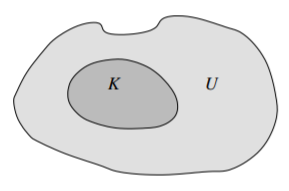4.3: The General Hartogs Phenomenon
- Page ID
- 74240
We can now prove the general Hartogs phenomenon as an application of the solution of the compactly supported inhomogeneous \(\bar{\partial}\)-problem. We proved special versions of this phenomenon using Hartogs figures before. The proof of the theorem has a complicated history as Hartogs’ original proof from 1906 contained gaps. A fully working proof was finally supplied by Fueter in 1939 for \(n=2\) and independently by Bochner and Martinelli for higher \(n\) in the early 40s. The proof we give is the standard one given nowadays due to Leon Ehrenpreis from 1961.
Let \(U \subset \mathbb{C}^n\) be a domain, \(n \geq 2\), and let \(K \subset \subset U\) be a compact set such that \(U \setminus K\) is connected. Every holomorphic \(f \colon U \setminus K \to \mathbb{C}\) extends uniquely to a holomorphic function on \(U\). See Figure \(\PageIndex{1}\).

Figure \(\PageIndex{1}\)
The idea of the proof is extending in any way whatsoever and then using the solution to the \(\bar{\partial}\)-problem to correct the result to make it holomorphic.
- Proof
-
First find a smooth function \(\varphi\) that is 1 in a neighborhood of \(K\) and is compactly supported in \(U\) (exercise below). Let \(f_0 = (1-\varphi)f\) on \(U \setminus K\) and \(f_0 = 0\) on \(K\). The function \(f_0\) is smooth on \(U\) and it is holomorphic and equal to \(f\) near the boundary of \(U\), where \(\varphi\) is 0. We let \(g = \bar{\partial} f_0\) on \(U\), that is \(g_k = \frac{\partial f_0}{\partial \bar{z}_k}\), and we let \(g=0\) outside \(U\). As \(g_k\) are identically zero near \(\partial U\), we find that each \(g_k\) is smooth on \(\mathbb{C}^n\). The compatibility conditions Equation (4.2.6) are satisfied because partial derivatives commute. Let us see why \(g_k\) is compactly supported. The only place to check is on \(U \setminus K\) as elsewhere we have \(g_k = 0\) automatically. Note that \(f\) is holomorphic on \(U \setminus K\) and compute \[\frac{\partial f_0}{\partial \bar{z}_k} = \frac{\partial }{\partial \bar{z}_k} \bigl((1-\varphi)f\bigr) = \frac{\partial f}{\partial \bar{z}_k} - \varphi \frac{\partial f}{\partial \bar{z}_k} - \frac{\partial \varphi}{\partial \bar{z}_k} f = - \frac{\partial \varphi}{\partial \bar{z}_k} f .\] And \(\frac{\partial \varphi}{\partial \bar{z}_k}\) is compactly supported in \(U \setminus K\) by construction. Now apply the solution of the compactly supported \(\bar{\partial}\)-problem to find a compactly supported function \(\psi\) such that \(\bar{\partial}\psi = g\). Set \(F = f_0 - \psi\). We check that \(F\) is the desired extension. First, it is holomorphic: \[\frac{\partial F}{\partial \bar{z}_k} = \frac{\partial f_0}{\partial \bar{z}_k} - \frac{\partial \psi}{\partial \bar{z}_k} = g_k - g_k = 0 .\] Next, Exercise 4.2.3 and the fact that \(U \setminus K\) is connected reveals that \(\psi\) must be compactly supported in \(U\). This means that \(F\) agrees with \(f\) near the boundary (in particular on an open set) and thus everywhere in \(U \setminus K\) since \(U \setminus K\) is connected.
The hypotheses on dimension and on connectedness of \(U \setminus K\) are necessary. No such theorem is true in one dimension. If \(U \setminus K\) is disconnected, a simple counterexample can be constructed. See the exercise below.
Show that \(\varphi\) exists. Hint: Use mollifiers.
Suppose \(U \subset \mathbb{C}^n\) is a domain and \(K \subset U\) is any compact set (perhaps \(U \setminus K\) is disconnected). Prove that given \(f \in \mathcal{O}(U \setminus K)\) there exists an \(F \in \mathcal{O}(U)\) that equals to \(f\) on the intersection of \(U\) and the unbounded component of \(\mathbb{C}^n \setminus K\).
Suppose \(U \subset \mathbb{C}^n\) is a domain and \(K \subset U\) is a compact set such that \(U \setminus K\) is disconnected. Find a counterexample to the conclusion to Hartogs.
One of many consequences of the Hartogs phenomenon is that the zero set of a holomorphic function \(f\) is never compact in dimension 2 or higher. If it were compact, \(\frac{1}{f}\) would provide a contradiction, see also Exercise 1.6.2.
Suppose \(U \subset \mathbb{C}^n\), \(n \geq 2\), is a domain and \(f \colon U \to \mathbb{C}\) is holomorphic. If the zero set \(f^{-1}(0)\) is not empty, then it is not compact.
Replacing \(U \setminus K\) with a hypersurface is usually called the Hartogs–Bochner theorem (when the hypersurface is \(C^1\) or smooth). The real-analytic case was stated first by Severi in 1931.
Suppose \(U \subset \mathbb{C}^n\), \(n \geq 2\), is a bounded domain with connected real-analytic boundary and \(f \colon \partial U \to \mathbb{C}\) is a real-analytic CR function. Then there exists some neighborhood \(U' \subset \mathbb{C}^n\) of \(\overline{U}\) and a holomorphic function \(F \colon U' \to \mathbb{C}\) for which \(F|_{\partial U} = f\).
- Proof
-
By Severi’s result (Theorem 3.2.1), for every \(p \in \partial U\), there is a small ball \(B_p\), such that \(f\) extends to \(B_p\). Cover \(\partial U\) by finitely many such balls so that if \(B_p\) intersects \(B_q\), then the (connected) intersection \(B_p \cap B_q\) contains points of \(\partial U\). The extension in \(B_p\) and in \(B_q\) then agree on a piece of a hypersurface \(\partial U\), and hence agree. Taking a union of the \(B_p\) we find a unique extension in single neighborhood of \(\partial U\). We write this neighborhood as \(U' \setminus K\) for some compact \(K\) and a connected \(U'\) such that \(\overline{U} \subset U'\). Consider the topological components of \(\mathbb{C}^n \setminus K\). As \(\partial U\) is connected and \(U\) is bounded, the unbounded component of \(\mathbb{C}^n \setminus K\) must contain all of \(\partial U\). By boundedness of \(U\), all the other components are relatively compact in \(U\). If we add them to \(K\), then \(K\) is still compact and \(U' \setminus K\) is connected. We apply the Hartogs phenomenon.
Let \(U \subset \mathbb{C}^n\), \(n \geq 2\), be a bounded domain with connected strongly pseudoconvex smooth boundary and let \(f \colon \partial U \to \mathbb{C}\) be a smooth CR function. Prove that there exists a continuous function \(F \colon \overline{U} \to \mathbb{C}\) holomorphic in \(U\) such that \(F|_{\partial U} = f\). Note: Strong pseudoconvexity is not needed (“bounded with smooth boundary” will do), but that is much more difficult to prove.
Suppose \(U \subset \mathbb{C}^n\), \(n \geq 2\), is a bounded domain of holomorphy. Show that \(\mathbb{C}^n \setminus U\) is connected using the Hartogs phenomenon.
Suppose \(W \subset U \subset \mathbb{C}^n\), \(n \geq 3\), are domains such that for each fixed \(z_3^0,z_4^0,\ldots,z_n^0\), \[ \bigl\{ (z_1,z_2) \in \mathbb{C}^2 : (z_1,z_2,z_3^0,\ldots,z_n^0) \in U \setminus W \bigr\} \quad \subset \subset \quad \bigl\{ (z_1,z_2) \in \mathbb{C}^2 : (z_1,z_2,z_3^0,\ldots,z_n^0) \in U \bigr\} .\] Prove that every \(f \in \mathcal{O}(W)\) extends to a holomorphic function on \(U\). Note: The fact that \(W\) is connected is important.
- Prove that if \(n \geq 2\), no domain of the form \(U = \mathbb{C}^n \setminus K\) for a compact \(K\) is biholomorphic to a bounded domain.
- Prove that every domain of the form \(U = \mathbb{C} \setminus K\) for a compact \(K\) with nonempty interior is biholomorphic to a bounded domain.
Suppose \(U \subset \mathbb{C}^n\), \(n \geq 2\), is a domain such that for some affine \(A \colon \mathbb{C}^2 \to \mathbb{C}^n\) the set \(A^{-1}\bigl(\mathbb{C}^n \setminus U\bigr)\) has a bounded topological component. Prove that \(U\) is not a domain of holomorphy.


